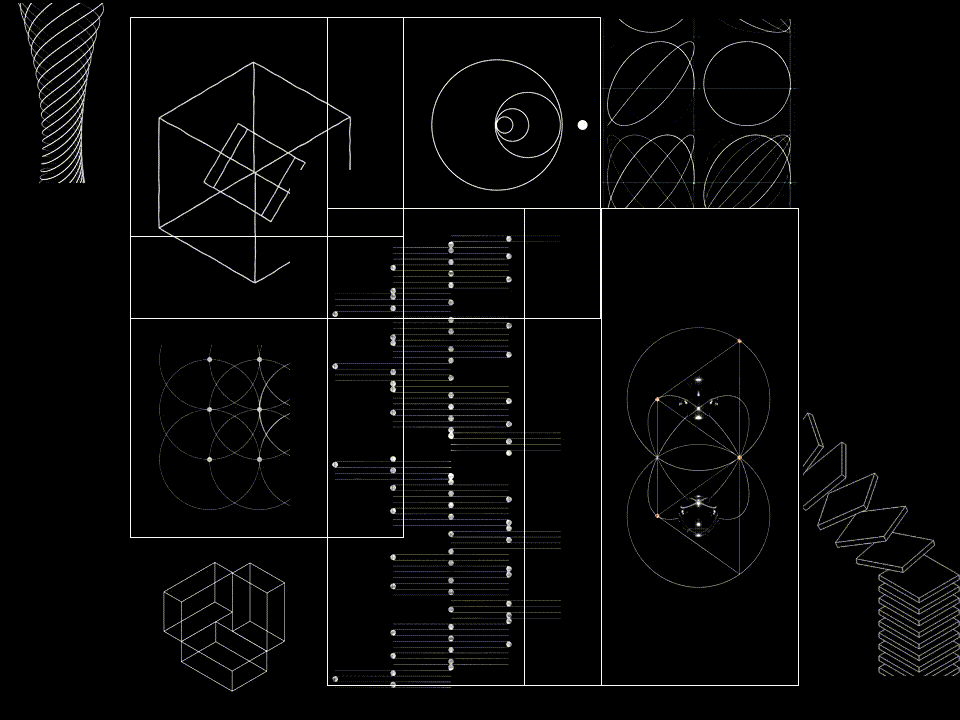Transformative Geometric Forms
Geometric abstract art integrates mathematical forms—such as circles, squares, triangles, and lines—to create structured and aesthetically pleasing compositions. Precision, symmetry, and the interplay between shapes and spaces provide a harmonious equilibrium that captivates observers. Cubism was another influential movement that impacted geometry. Its objective was to deconstruct objects into their geometric components and concurrently depict them from multiple perspectives. This innovative approach allowed artists to challenge traditional notions of representation and perspective, leading to a new way of seeing the world. By fragmenting forms and rearranging them on the canvas, Cubism paved the way for future movements that would further explore abstraction and spatial relationships in art.Sculptor Louise Nevelson articulated her desire to create in an open space while concurrently feeling the need to confine her little works inside tiny enclosures. The cube’s philosophical significance, as she articulated, is “terra firma”—a means to ground flights of imagination. Through her innovative use of materials and structure, Nevelson transformed simple objects into profound statements about existence and identity.Her analytical mind saw the geometric box as a rational framework, while her imagination facilitated the creation of its contents.
In 1899, Louise Nevelson was born Leah Berliawsky in Pereiaslav-Khmelnytskyi, Russia (now Ukraine). She emigrated to the United States as a child. In 1931–32, Hans Hofmann instructed Nevelson in abstract painting in Munich and New York. He introduced her to collage and Cubism, which significantly influenced her artistic endeavors. In the late 1950s, Nevelson initiated the production of monochrome, spray-painted wooden assemblages. These abstract creations were achieved by stacking found objects from the streets to create sculptural walls and settings, which were subsequently painted with a single hue. Nevelson would place these objects on the streets, arrange them to form sculptural walls and environments, and then apply a single color to them. The transformative impact of Louise Nevelson on the art world is undeniable. By integrating collage and Cubist principles into her practice, she redefined the boundaries of sculpture and mixed media. Her innovative approach in the late 1950s, characterized by monochrome, spray-painted wooden assemblages, showcased a unique aesthetic that challenged traditional notions of form and space. Through her skillful stacking of found objects, Nevelson breathed new life into discarded materials and elevated everyday items to the realm of fine art. Moreover, her creation of sculptural walls and settings painted in singular hues further emphasized her commitment to abstraction while inviting viewers into immersive environments that transcended conventional artistic experiences. Together, these elements not only highlight Nevelson’s pioneering spirit but also solidify her legacy as a formidable force in contemporary art.
Night Flight 1 exemplifies Nevelson’s remarkable oeuvre. This work comprises nine distinct box sculptures constructed from assorted found items, all integrated inside an uneven framework. The items consist of the rear of a chair, segments of molding, and wooden discs. Nevelson imbued her art with an aura of mystery by applying a layer of her preferred hue, “aristocratic black.” Her cryptic oeuvre encapsulates motion and equilibrium on a grand scale. To examine Night Flight 1 in further detail, please use either the elevator or the stairs to reach the mezzanine level and report to the Port of Seattle office lobby. This artwork was among the first purchases by the Port of Seattle in the early 1970s. The artist’s choice to apply a layer of “aristocratic black” adds an element of mystery, inviting contemplation and engagement with the piece. As visitors pass through, they are not merely observing art but experiencing a visual journey that captures the essence of movement within stillness, making “Night Flight 1” an enduring symbol of creativity and innovation at the heart of Seattle’s maritime identity.
Between 1972 and 1973, Louise Nevelson created a series of sculptures known as Dream Houses. In these works, she employed her most recognized artistic method: accumulating small pieces of wood into a larger structure that she then used. She used a consistent, unifying color, specifically black, which is common in much of her artwork, though it is not universally applicable. This choice of color not only emphasizes the form and texture of the wood but also evokes a sense of mystery and depth in the sculptures. Nevelson’s Dream Houses invite viewers to explore the interplay between light and shadow, creating an immersive experience that captivates the imagination.The design incorporates oblong shapes, circular cut-outs, and unconventional elements, such as shards or protrusions, that interlock to create the appearance of concealed chambers. The structure, positioned between a box and a column, encourages engagement with its collections and voids, resembling a complex puzzle to resolve. This innovative approach challenges traditional architectural norms, inviting visitors to explore and interact with the space in unexpected ways. As they navigate through its intricate layout, they discover new perspectives and experiences that enhance their understanding of the art within.Her art engenders an illusion of openness and an aversion to permanence. In her series, she amalgamates many shapes via blackness, accentuating shared traits and underlining her commitment to grayscale and the act of integration. Through her work, she encourages a dialogue about the transient nature of existence and the beauty that can be found within that impermanence.
Nevelson saw herself not as a painter or sculptor, but as an architect constructing with shadow and light. Her passion for Cubism motivated her to consistently create art that celebrated movement—an embodiment of the fourth dimension. By designing immersive environments, Nevelson transformed spaces into sanctuaries that encouraged both physical exploration and introspective journeys for the body and mind.



